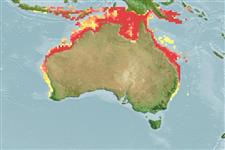Common names from other countries
>
Scombriformes (Mackerels) >
Scombridae (Mackerels, tunas, bonitos) > Scombrinae
Etymology: Scomberomorus: Latin, scomber = mackerel + Greek, moros = silly, stupid (Ref. 45335).
Environment: milieu / climate zone / depth range / distribution range
Ecologie
marien; brak water; oceanodroom (Ref. 51243); diepte 1 - 100 m (Ref. 6390), usually ? - 30 m (Ref. 6390). Tropical; 7°S - 35°S, 110°E - 157°E (Ref. 168)
Western Pacific: largely confined to inshore coastal waters of southern Papua New Guinea and northern and eastern Australia, from Shark Bay and Onslow, Western Australia to Sydney, New South Wales. This species was confused with Scomberomorus guttatus.
Lengte bij maturiteit / Grootte / Gewicht / Leeftijd
Maturity: Lm ?, range 48 - ? cm
Max length : 100.0 cm FL mannelijk / geslacht onbekend; (Ref. 168); common length : 80.0 cm FL mannelijk / geslacht onbekend; (Ref. 168); max. gepubliceerd gewicht: 12.2 kg (Ref. 3132)
Dorsale stekels (totaal) : 16 - 18; Dorsale zachte stralen (totaal) : 17 - 19; Anale stekels: 0; Anale zachte stralen: 16 - 20; Wervels: 48 - 49. Interpelvic process small and bifid. Lateral line gradually curving down toward caudal peduncle. Intestine with 2 folds and 3 limbs. Swim bladder absent. Body covered with small scales. Membrane of first dorsal fin jet black with large contrasting areas of intense white between the 6th and the last spine. Sides of adults marked with about three indefinite rows of indistinct bronze-gray blotches (absent in 9.5 cm juveniles).
Schooling species which moves into inshore waters, bays and estuaries of Queensland during the southern midwinter and early spring. Often inhabit very turbid coastal waters shallower than 30 m (Ref. 6390). Common length 50 to 80 cm FL (Ref. 12241). Seasonally migratory in the Gulf of Carpentaria and form mixed schools with S. commerson over shallow reefs offshore of Queensland. Trolling lines with lures such as metal spoons and cut bait are used by recreational and commercial fishermen. Mostly marketed fresh (Ref. 9987).
Levenscyclus en paargedrag
Maturities | Voortplanting | Spawnings | Egg(s) | Fecundities | Larven
Collette, B.B. and C.E. Nauen, 1983. FAO Species Catalogue. Vol. 2. Scombrids of the world. An annotated and illustrated catalogue of tunas, mackerels, bonitos and related species known to date. Rome: FAO. FAO Fish. Synop. 125(2):137 p. (Ref. 168)
Status op de Rode Lijst van het IUCN (Ref. 130435)
CITES (Ref. 128078)
Not Evaluated
Gevaar voor de mens
Reports of ciguatera poisoning (Ref. 6390)
Gebruik door de mens
Visserij: commercieel; sportvis: ja
Tools
Speciale rapporten
Download XML
Internetbronnen
Estimates based on models
Preferred temperature (Ref.
115969): 24.5 - 28.6, mean 27.4 (based on 302 cells).
Fylogenetische diversiteitsindex (Ref.
82804): PD
50 = 0.5000 [Uniqueness, from 0.5 = low to 2.0 = high].
Bayesian length-weight: a=0.00832 (0.00383 - 0.01808), b=3.03 (2.86 - 3.20), in cm Total Length, based on LWR estimates for this Genus-body shape (Ref.
93245).
Trofisch niveau (Ref.
69278): 4.5 ±0.8 se; based on diet studies.
Weerstandsvermogen (Ref.
120179): Gemiddeld, minimale populatieverdubbelingstijd 1,4-4,4 jaar (tm=1-2).
Fishing Vulnerability (Ref.
59153): Low to moderate vulnerability (33 of 100).
